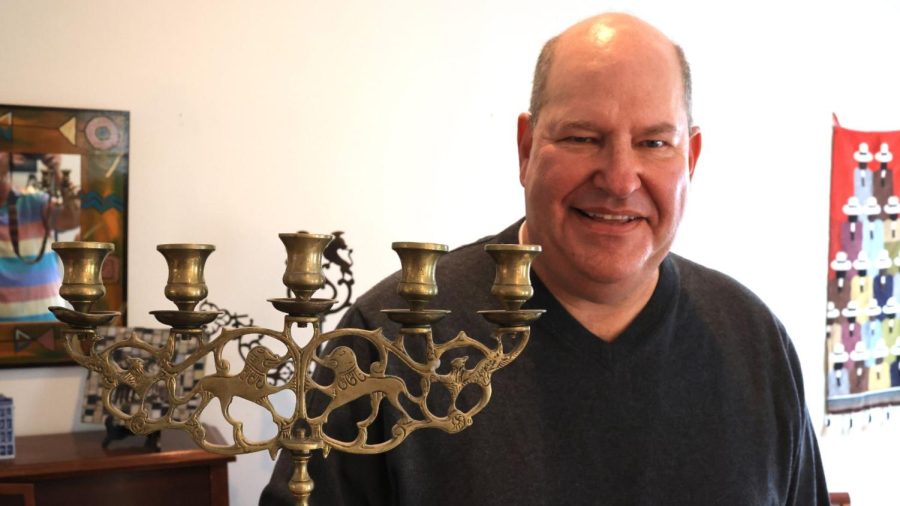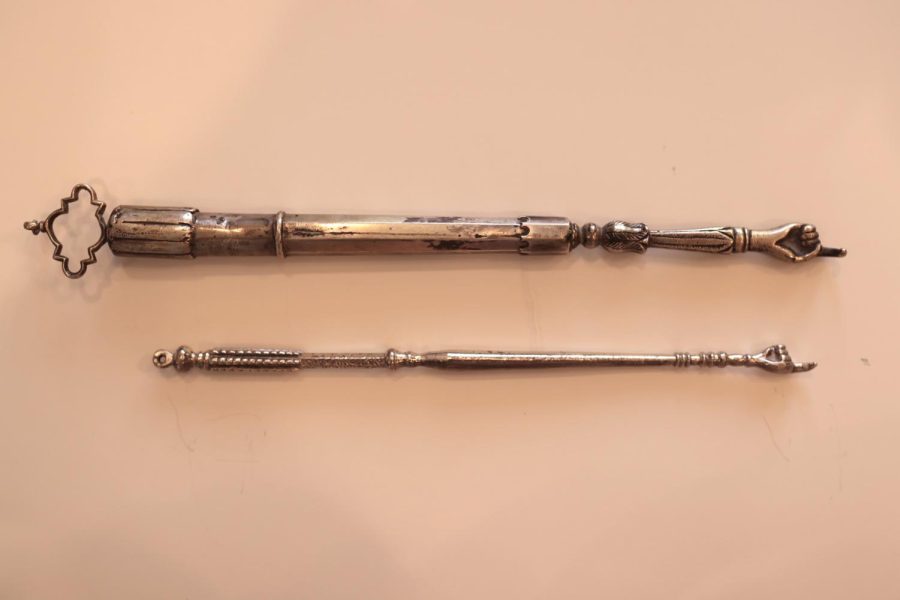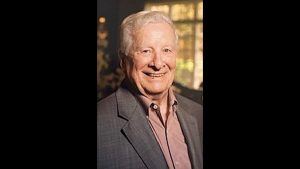St. Louis collector of Judaica immerses in Jewish history, one antique at a time
St. Louisan Marc Lapp (below) collects vintage Judaica. His collection includes carved wooden lion (from the mid-1900s) and the silver Torah finials
Published March 24, 2023
When Marc Lapp was growing up, he collected coins, always looking for unicorns like a 1955 double die penny. Lapp is still collecting, but he specializes in antique Judaica.
Lapp, a member of Congregation B’nai Amoona, first got hooked on vintage Judaica nearly 30 years ago on a trip to the Chicago suburb of Highland Park. He and his wife were visiting Lapp’s father-in-law, and he visited a Judaica shop run by Arthur Feldman.
“I walked in, and I was just awestruck by all of the Jewish objects I saw,” said Lapp, 60. “I could tell they were antiques. And I started up a conversation with Mr. Feldman. He explained how to buy pieces, and I went to visit him every time we went up there.
ADVERTISEMENT
“I said, ‘I want to start a collection. What would you suggest?’ He went downstairs and brought up about 100 auction catalogs from Sotheby’s, Christie’s and Swan. He said, ‘You need to study these catalogs so that you have an eye for whatever you think you’re going to collect because there’s a lot of fake stuff out there.’ ”
Lapp, a lawyer who is naturally inquisitive, was eager to begin collecting after careful research and verifying the authenticity of items. Proof of provenance is a key for collectors of any antiquity, Lapp said, and he makes sure that the pieces he buys at auction are legit.
Like many collectors, Lapp enjoys the thrill of the hunt and the sometimes nerve-racking anticipation during online bidding. Mostly, though, he loves learning as much as he can about the artifacts.
ADVERTISEMENT
“I enjoy the stories,” Lapp said. “I’m collecting the stories, the understanding of the piece and its relationship to Judaism. Sometimes I’m able to trace the piece to a family who used it. There are stories that each one has. That’s the fun part for me about collecting them.”
A good example is a small silver cup from Lapp’s collection that could have been used as a kiddush or Passover seder cup. It appears unremarkable until you turn it over.
“On the bottom, it’s got all the clues,” Lapp said. “The ‘zwaggle’ (zagged line) denotes the purity. The initials tell who the maker was, and the strawberry is the city mark for Augsberg, Germany. The 40/22 is where the real story comes in. It was seized by the German authorities from a Jewish family. The 40 was 1940, and the 22 means it was the 22nd item seized.”
Lapp did some additional research to confirm more of the cup’s history. The initials “PS” stand for Phillipp Stenglin, a German silversmith who produced a number of works between 1717 and 1734.
Other pieces in Lapp’s collection are authentic but they have a vague history. One is a Torah pointer, or yad.
“It’s a solid piece of silver from Amsterdam from around 1800,” Lapp said. “If you look closely at the finger, you’ll see it’s worn a little bit. That’s an important sign on authenticity, the wear on the tip where it passes over the parchment line by line on the Torah. It may have belonged to a wealthy family and was used with a smaller Torah in someone’s home.”
Lapp gingerly held up another delicate, thin yad with a red ribbon attached.
“This one is really special,” he said. “It’s made of brass and has inscriptions on all four sides from the Book of Psalms. It’s from Iraq, made around 1850. It has beautiful flowers on top and is hand-hammered. It’s a piece of folk art.”
Antique Judaica takes many forms, and a new collector can enter the market by purchasing items starting at a few hundred dollars. Like any antiquity, the price goes up depending on the rarity of a piece. Lapp said the rarest items sell at auction for up to $50,000. Some collectors stick to specific types of pieces, including menorahs, mezuzahs and Torah pointers.
Lapp’s collection includes a wide variety of antiquities. He selects them for their uniqueness, beauty, craftmanship and history, if he can find it. One of his more unusual pieces is a tall, intricately designed spice box. It is made of hand-turned silver and dates back to about 1801. It was made in Budapest and is, he said, “museum quality, with fine filigree work.”
If you’re thinking about diving into antique Judaica collecting, Lapp recommended staying away from eBay. Authenticating items is important and it’s difficult to do buying online from a seller you don’t know. Lapp also suggested working with an expert to provide assistance.
“You need to form a relationship with that person, like the one I started with Mr. Feldman,” Lapp said. “When I would find something, I would sometimes buy it and show it to him, or show him a picture and ask him, ‘Is this authentic?’ and get an opinion. I also bought things from his store.
“And I continued to collect catalogs from the auction houses, like J. Greenstein Galleries, which is about 25 years old. It is run by a gentleman named Jonathan Greenstein. He’s an Orthodox Jew in his mid 60s. He has learned the marketplace really, really well and he’s become the guy that I’ll either buy from or show pieces to so I can make sure that what I’ve got is authentic.”

















